Iced tea
Iced tea (or ice tea[1]) is a form of cold tea. Though usually served in a glass with ice, it can refer to any tea that has been chilled or cooled. It may be sweetened with sugar, syrup and/or apple slices. Iced tea is also a popular packaged drink and can be mixed with flavored syrup, with multiple common flavors including lemon, raspberry, lime, passion fruit, peach, orange, strawberry, and cherry.

While most iced teas get their flavor from tea leaves (Camellia sinensis), herbal teas are sometimes served cold and referred to as iced tea. Iced tea is sometimes made by a particularly long steeping of tea leaves at a lower temperature (one hour in the sun versus five minutes at 80 to 100 °C (176 to 212 °F), which is known as sun tea.
Cultural variations
Austria
Iced tea is popular in Austria and is commonly known as Eistee (ice tea); it is usually drunk heavily sweetened. Pfanner and Rauch are two of the most popular manufacturers.
Belgium and the Netherlands
In Belgium, the Netherlands (ijsthee), and other parts of Europe, "Ice-Tea" is the brand name of a carbonated variety of iced tea marketed by Lipton since 1978. They also market other non-carbonated iced teas under the "Ice Tea" brand.
Brazil
In Brazil, particularly in Rio de Janeiro, one of the most popular beverages is mate or chá mate. Unlike the Argentinian or gaucho mate (also known as chimarrão), the carioca rendering is consumed iced and sweetened. A preferred flavouring is lime juice (not lemon), referred in Rio as "mate com limão". It is a part of the local beach culture, where it is sold by walking vendors in portable coolers. Mate dried leaves can be bought in supermarkets to be made at home. The most popular brand is Leão, originally from Paraná, and later acquired by The Coca-Cola Company. It is generally left overnight at the refrigerator. Leão also markets mate as a non-carbonated soft drink.
Canada
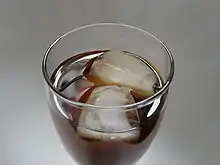
In Canada, iced tea refers to sweetened iced tea, flavored with lemon. The iced tea is usually made at home from drink powder or obtained in bottles or cans. Sweetened green teas and those flavored with raspberry, peach, or pomegranate are becoming more common via marketing efforts. Sweetened iced tea is often served as an alternative to other soft drinks, prepared by companies like Arizona, Nestlé (Nestea) and Brisk. Many health foods and specialty stores carry iced tea made of whole-leaf tea without additives. Fresh-brewed iced tea is also popular, particularly in smaller independently owned restaurants. Powdered or frozen iced tea is a common preparation at home, due to its ease of use.
China
Although not a traditional way to serve tea, iced tea gained widespread popularity in even rural areas since the late 1980s with canned or bottled tea. Many varieties of tea, including green tea, are available packaged and sold in stores. Many families make their iced tea by either putting much ice in a small amount of strong hot tea or by putting hot tea in a fridge for some time. Common types of iced tea are black, green, oolong (烏龍茶), and many herbals as well. Iced herbal teas are especially popular in the hot summers, where "yin"(陰)or cooling herbs are used to make tea such as chrysanthemum, kuding tea (苦丁茶), etc. Cooled tea (but still warm) was popular throughout ancient times. Refrigerated tea was only available to those politically connected to the Communist Party. The introduction of limited capitalism and the opening markets in the 1990s made refrigeration available to the general population for the first time. China's refrigerator-ownership increased from just 7% of urban families in 1997 to 95% in 2009.[2]
Denmark
Iced tea is sold in 7-Eleven stores and supermarkets.
Germany
Nestea, Lipton, and Pfanner are the most dominant brands and lemon- and peach-flavored iced teas are the most popular variants. Lipton offers several non-carbonated iced teas under the "Ice Tea" brand and the carbonated variety under the brand "Ice Tea Sparkling". Iced tea is also available in many restaurants and cafés. Half-sweetened iced tea (i.e. 50 g/l sugar compared to the 100 g/l found in soft drinks) is available in most big supermarkets, mainly "Lipton Green". Instant teas are available that can be used to prepare iced tea with cold or hot water which are often called "Krümeltee" (meaning crumb tea or crumble tea) because of its characteristic appearance.
Greece
Ice tea in Greece is primarily either lemon or peach flavor. Most dominant brands are Lipton, Fuze Tea, Arizona, Nestea, and Life Tsai. Lately, new flavors have appeared but have not reached the popularity of lemon and peach, though varieties of these exist such as no sugar or with green tea with the above flavorings. Sparkling Ice Tea is almost non-existent, but there is powdered Ice Tea available in supermarkets. Ice Tea not concerning the brand is readily available in most restaurants, usually served with ice and a lemon slice (regardless of being lemon or peach). In addition to the classical Ice Tea, there also exists canned cold mountain tea branded by a different company called tuvunu (Greek: τού βουνού) meaning "of the mountain". This variant is currently less popular, possibly due to its recent entry to the market. Overall, Ice Tea is one of the most popular non-alcoholic beverages in Greece in the top three with cola and orange juice.
Hong Kong
Iced lemon tea is available at many Hong Kong restaurants. A strong black tea (e.g., Ceylon) is brewed at length in a metal pot over a burner and prepared as follows: a large glass is filled with ice, a scoop of simple syrup is added (if desired), and the glass is filled to the top with hot tea. Slices of lemon are placed atop the mixture, which are then muddled into the tea by the customer, ensuring that the volatile oils present in the lemon peel are at their peak when consumed.
In dessert parlors (such as "Quickly"), iced green tea is often available (usually flavored with jasmine blossoms), with and without tapioca pearls, as is Hong Kong milk tea (usually served warm in cafes, but poured over ice when served with tapioca, creating a very creamy iced tea).
India
Iced tea is a common drink in India, found at most restaurants, hotels, and malls. The most popular form of iced tea in India is ginger lemon iced tea or lemon iced tea. Other kinds are rather uncommon, though peach iced tea is quite popular. Brands of iced tea include Lipton and Nestlé, which have become affiliated with the same.
Nepal
Iced tea can be found at some of the restaurants and cafes in Nepal. Mainly it can be found around the tourist areas such as the Boudhanath area, Thamel and some other major malls. Some variations are lemon, green mint, peach, etc.
Indonesia
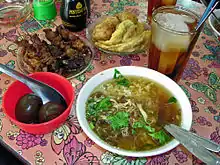
Iced tea is a popular drink in Indonesia. It is served in a vast majority of foodservice businesses, ranging from street hawkers and traditional food corners to high-end restaurants. Iced tea is sweetened; it is known as "es teh manis" and is served with a meal. Bottled brands include Sosro and Lipton.
Italy
Iced tea is a popular drink in Italy and is widely available, generally only in lemon- and peach-flavored incarnations. Estathé (which was first released in 1972 by Ferrero) and Lipton are well-known brands.
Japan
Japan is one of the most important iced tea markets in the world, with iced tea in bottles and cans a common sight in the country's ubiquitous vending machines. Japanese iced-tea products mirror the market for hot tea in the sense that they are mostly green tea and oolong products, usually unflavoured and mostly unsweetened. Suntory, Kirin, and the Coca-Cola Company are some of the largest producers. Lipton, the world's largest tea brand, offers a range of iced tea products based on black tea through joint ventures with two local partners, Suntory and Morinaga. Black tea products are sweetened with sugar and come in a variety of flavors, including lemon, peach and unflavored. Milk tea is another flavor of black tea that is particular to the Japanese market. Kirin Beverage also offers a few carbonated black tea products.
Japanese-style products rather than the Western-style products are penetrating the markets of East Asia. Several Japanese companies have started exporting their products to Europe and North America, in particular Ito En, which markets a whole range of Japanese-style unsweetened green and oolong teas in the United States.
Malaysia
Iced tea is very popular in Malaysia and is sold in most restaurants and grocery stores. The two most common types of tea are plain Chinese iced tea (teh o' ais) and iced lime tea (teh o' ais limau). Both varieties can be bought at most coffee shops and restaurants and are usually made by the outlet, though canned and bottle iced lemon tea is readily available at grocery stores. Popular brands of iced lemon tea are Lipton, Nestea, and F&N Seasons as well as F&N iced tea of Oishi.
Philippines
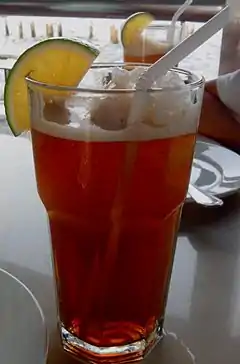
Iced tea is served in many bars, restaurants, grocery stores, schools, and fast food outlets as an alternative to carbonated soda. In most areas, the Nestea brand is the most popular. It is available in powdered form as well as in cans and bottles. Iced tea in the Philippines is almost always sweet, with a slight lemon flavor.
The most common variations are lemon and calamansi iced teas. Some brands offer bottled iced tea.
Portugal
Iced tea has been a popular drink in Portugal since the early 1990s. It is sold in cans and bottles found in bars, restaurants, grocery stores, and supermarkets. Lipton Ice Tea, Nestea and Frutea are the leading brands. The most common types of iced tea sold in Portugal are lemon, peach or mango flavored.
Romania, Hungary and Bulgaria
Although not produced traditionally (tea is usually served hot, with lemon and sugar/honey), iced tea became popular in these countries following the fall of the Eastern bloc in 1989–1990. Iced tea is mainly available in shops, being sold by companies such as Lipton and Nestea.
Singapore
Iced tea is widely drunk both in bottled and teabag version, (Nestea and Lipton are the most common in supermarkets.) although it is not served traditionally where tea is hot, it is still the most known tea and is well-liked by most.
South Africa
Iced tea has become increasingly popular in South Africa and is now widely available in cafes and retail outlets countrywide. Nestea, Lipton, Manhattan and Fuze Tea are the most popular brands, in addition to the South African brand BOS, which uses rooibos sourced locally from the Western Cape.[3]
South Korea
Cold tea (usually without ice) is popular during the summer months in South Korea. Common varieties include corn, barley, and green tea. Bottled iced tea is found in nearly all grocery and convenience stores.
Sweden
The two dominating brands are Lipton and Nestea—the two best-selling flavors are lemon and peach. Iced tea is also sold in grocery stores and some restaurants.
Switzerland
Mass-produced iced teas such as Nestea (Nestlé), Migros Ice Tea and Lipton are popular refreshments, while fresh-brewed iced teas are seldom found outside the home. Iced herbal teas, typically dominated by peppermint, are readily available, as are flavored black teas. It is typically labeled as "ice tea".
Switzerland is considered the motherland of bottled iced tea. Ruedi Bärlocher and Martin Sprenger, two employees of the Swiss Bischofszell beverage company, had tried the famous American iced tea and first suggested to produce ready-made iced tea in bottles. In 1983 Bischofszell Food Ltd. became the first producer in the world of bottled ice tea on an industrial scale.[4][5]
Taiwan
Bubble tea is usually a strong black tea, sweetened with sugar and condensed milk. It is served cold, usually with tapioca pearls. There are many variations of it, made with different types of teas; fruit-flavored bubble teas are popular as well. Sometimes pudding, jelly, or chunks of fruit are put into it instead of tapioca pearls.
Thailand
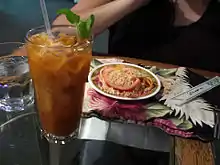
Thai iced tea or cha yen (Thai: ชาเย็น) in Thailand is a drink made from strongly brewed black tea. It is sweetened with sugar and condensed milk and served chilled. Evaporated milk, coconut milk or whole milk is generally poured over the tea and ice before serving to add taste and creamy appearance. However, in Thailand, condensed milk and sugar are mixed with the tea before it is poured over ice and then topped with evaporated milk. In Thai restaurants worldwide, it is served in a tall glass, though in Thailand it is more typically poured over the crushed ice in a clear (or translucent) plastic cup.
Additional variations include:
- Dark Thai iced tea (Thai: ชาดำเย็น, cha dam yen): Thai tea served chilled with no milk content and sweetened with sugar only. The concept is based on traditional Indian tea, which is used as the main ingredient.
- Lime Thai tea (Thai: ชามะนาว, cha manao): Similar to dark Thai iced tea but flavored with lime as well as sweetened with sugar. Mint may be added.
Turkey
In a traditionally tea-drinking country such as Turkey, with its own tea and tea culture, iced tea became popular when Lipton introduced it in the 2000s. Iced teas are a popular alternative to soft drinks. Lipton and Nestea were the two major brands until 2012 when the contract between Coca-Cola İçecek A.Ş. and Nestea expired. Coca-Cola replaced Nestea with its Fuze Beverage brand, but due to the word füze meaning "missile" in Turkish, the name used for the Turkish market is Fuse Tea. The national tea company Çaykur is in the market with its iced tea brand 'Didi'.[6]
United Kingdom
Although iced tea is not as widely consumed in the United Kingdom as in Europe, the drink became more popular in the 2000s.[7] In the 1990s Lipton sold a carbonated iced tea, similar to the one sold in Belgium. In recent years, Lipton has returned to the general sale of non-carbonated tea, quickly followed by Nestea and Twinings.
United States
In the United States, iced tea makes up about 85%[8] of all tea consumed and is very popular as an alternative to carbonated soft drinks, especially as a characteristic beverage of the American South. It is ubiquitous in grocery stores, convenience stores, restaurants, vending machines, and soda fountains. It may be freshly made on-premises or available in bottles and cans and at self-serve soda fountains.
Vietnam
In Vietnam, iced tea is often served free in coffee shops and some restaurants while the customer is deciding what to order.
History
The oldest printed recipes for iced tea date back to the 1870s. Two of the earliest cookbooks with iced tea recipes are the Buckeye Cookbook[9] by Estelle Woods Wilcox, first published in 1876, and Housekeeping in Old Virginia[10] by Marion Cabell Tyree, copyright 1878.[11]
Iced tea started to appear in the United States during the 1860s. Seen as a novelty at first, during the 1870s it became quite widespread.[12] Recipes appeared in print, iced tea was offered on hotel menus, and it was on sale at railroad stations.[13] Its popularity rapidly increased after Richard Blechynden introduced it at the 1904 World's Fair in St. Louis.[14]
Iced tea's popularity in the United States has led to an addition to standard cutlery sets: the iced tea spoon is a teaspoon with a long handle, suitable for stirring sugar in the tall glasses in which iced tea is usually served. Iced tea is at its most popular in the summer.
It is a common stereotype of the Southeastern United States that due to the popularity of sweet iced tea in the region, unsweetened iced tea is not available or is frowned upon. It is often the case, however, that the term "tea" is assumed by default to mean sweetened iced tea in that region.
Varieties
Iced tea is traditionally served with lemon slice used as a garnish, which is often placed on the rim of the glass. In the Southwest United States (or at least in restaurants with a Southwest theme), lime is also very popular (especially in Mexican restaurants). It is not entirely uncommon for establishments to put out slices of lemon and lime for the customer to take for themselves. Many people in the Southeastern USA will also drink sweet (iced) tea with milk.
Because of the varieties of eateries in the United States, as well as climatic and cultural differences, a variety of iced teas are available. Most prominent are:
- In barbecue, soul food, and Southern cuisine-style, establishments, along with diners and general eateries, black tea is iced. This is by far the most commonly available form of freshly brewed iced tea, to which the above statements apply. Fruit-flavored teas and herbal teas are also popular iced.
- In some coffeehouses, more exotic varieties may be iced, such as Jasmine tea or Earl Grey tea.
- Thai iced tea is common in Thai restaurants.
- Iced chai (spiced Indian tea) is available from some restaurants and stores. While not traditionally served iced, in the U.S. chai is frequently served iced, with honey as a sweetener, or pre-sweetened when bottled.
- Iced Jasmine tea, Genmaicha, and Hōjicha are available from some Chinese cuisine or other Asian cuisine restaurants, but rarely. It is more common to find one of these varieties hot, where the patron may pour the tea over ice.
Bottled iced tea
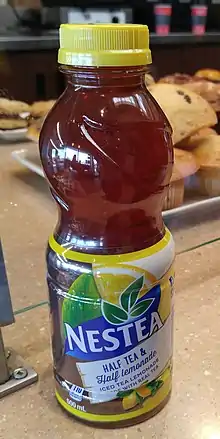
Popular manufacturers of bottled or canned iced tea include Arizona, Honest Tea, Lipton, Nestea, Snapple and Turkey Hill. Such tea can be found on the shelves of most Western groceries and convenience stores, or online, in a variety of flavors and leaf types (usually black or green, occasionally white). With iced tea mass-produced at this scale, unsweetened varieties are somewhat rare: Most are sweetened with corn syrup, and their sweetness places them in the same market as soft drinks. Brands such as Snapple and Lipton offer iced teas sweetened with sugar in place of corn syrup. Both the sweetened and unsweetened varieties usually contain the additive citric acid, labeled either "for flavor" or as a "preservative." Canned varieties are canned under high pressure to prevent the cans from being crushed, which may result in very mild effervescence.
Health food and some other specialty stores often carry a different set of iced tea bottles which may include Role Tea, Tazo, Sweet Leaf Tea, MaryAnna's Tea, U.S. brands of the Japanese green tea giant Ito En, and other small companies. These are available in a variety of flavors, although there is less emphasis on fruits and sweeteners and greater emphasis on traditional tea spices and herbs (which can range from mint to the oil of bergamot). Corn syrup as a sweetener is rare, with cane sugar, honey, and other sweeteners being more prominent. Citric acid as a stand-alone ingredient (i.e., present as a chemical additive and not because of the addition of citrus) is less common. With these alternative producers, unsweetened tea with no additional ingredients (just tea-infused water) may be available, as well as uncommon varieties such as chai tea, white tea, genmai tea, Jasmine tea, Earl Grey tea, and hoji tea.
Sweet tea
Sweet tea is a tea that is brewed very strong with a large amount of sugar added while the tea is hot. The mixture of sugar and tea is then diluted with water, served over ice, and occasionally garnished with lemon. Sometimes the diluted mixture is allowed to cool to room temperature. Other times the sugar and tea mixture is diluted by pouring the hot tea and sugar over a full tumbler of ice to cool it instantly. Sweet tea is traditionally the most common variety of iced tea in the American South; elsewhere in the United States, unsweetened iced tea is more common, although there has been a growing trend of offering both sweetened and plain since the early 2000s. Because of the popularity of sweet tea in the south, plain iced tea is often called unsweet tea.
Sun and refrigerator tea
Iced tea can be brewed by placing tea (bags or loose-leaf) in a large glass container with water and leaving the container in the sun for hours. This often results in a smoother flavor. An advantage is that sun tea does not require using electricity or burning fuel, thus saving energy. Sun tea is sometimes served with syrup or lemon.
The temperature of the tea brewed in this manner is never heated high enough to kill any bacteria, leaving the water potentially unsafe to drink. The tea should be discarded if it appears thick, syrupy, or has rope-like strands in it, though it may be hazardous even without such indicators.[15]
Because of this danger an alternative called "refrigerator tea" has been suggested where the tea is brewed in the refrigerator overnight. This has the dual advantage of preventing the growth of harmful bacteria and the tea already being cold without the addition of ice.[16]
Fountain iced tea
In 1996, the City of Cincinnati's Health Department discovered high levels of coliform bacteria (due to inadequate daily cleansing) in the spigots of dispensers filled by automatic fresh brewed iced tea machines in several area restaurants.[17] Approximately the same time, the Coca-Cola and Pepsi Cola companies began aggressive targeted marketing campaigns aimed at replacing fresh brewed iced tea in foodservice establishments with the cola companies' tea concentrate that is dispensed using the same method as fountain drinks, pumped from a bag-in-box. In many cases, the cola companies provided a fountain dispenser for the tea concentrate that looked similar to the containers that were previously used to dispense fresh-brewed tea.
Half-and-half
There has been a growing popularity in the United States of a mixed drink called "half-and-half" since the late 1960s when golf-great Arnold Palmer ordered one in Palm Beach, Florida.[18] Half-and-half is a mix of iced tea and lemonade, giving the drink a much sweeter taste. Often called an "Arnold Palmer" (although Palmer himself preferred a ratio of two parts iced tea to one part lemonade[19]), the drink was eventually marketed by Snapple, Nantucket Nectars, and AriZona Iced Tea; AriZona has licensed Arnold Palmer's name and image for its versions. In 2012 an ESPN short documentary was produced on the drink, featuring Palmer, beverage experts, a group of PGA golfers and comedian Will Arnett discussing the drink's history and popularity.[20] A John Daly is an alcoholic version of the drink, often made with sweet tea, vodka, and lemonade.
Another popular use for the term "half-and-half" is that of a mixture of sweetened and unsweetened tea at a restaurant or fast-food establishment that offers both choices. This provides a middle ground for those who want sweetness but not as much as the sweet tea being served.
See also
References
- "New words list December 2012". Oxford English Dictionary. Retrieved March 14, 2013.
- "What Do Chinese Dumplings Have to Do With Global Warming?". The New York Times. 27 July 2014.
- "BOS – Not just an ice tea".
- Bischofszell Food Ltd. Archived 2013-01-17 at the Wayback Machine
- www.20minuten.ch; 20 Minuten; 20 Min; www.20min.ch. "20 Minuten – So kam der Eistee in die Schweiz – News". 20 Minuten.
- "Lipton Ice Tea Çaykur Didi Ve Fuse Tea'ye Karşı – Brand Talks – Burada Markalar Konuşur!". Brand Talks – Burada Markalar Konuşur!.
- "Ice Ice Baby". UK Tea Council. Retrieved 3 August 2011.
- Tea Fact Sheet Tea Association of the USA (2/1/2008).
- Wilcox, Estelle Woods (1905). "Iced Tea". The Original Buckeye Cook Book and Practical Housekeeping: A Compilation of Choice and Carefully Tested Recipes. Reilly & Britton Company. p. 188. Retrieved 2012-07-01 – via Google Books.
- Tyree, Marion Cabell (1878). "Iced Tea". Housekeeping in Old Virginia. Louisville, Kentucky: John P. Morton & Co. p. 64. Retrieved 2012-07-01 – via Internet Archive.
- "Feeding America Project". Digital.lib.msu.edu. Retrieved 2009-06-29.
- "When was iced tea invented?". Quezi.com. 2009-03-11. Archived from the original on 2009-06-18. Retrieved 2009-06-29.
- Olver, Lynne. "Ice Tea". The Food Timeline. Retrieved 2009-06-29.
- "Iced Tea: The Distinctively American Beverage". Teausa.com. Retrieved 2009-06-29.
- Mikkelson, Barbara (2006-06-10). "Bacteria in Sun Tea Risk". Snopes.com. Retrieved 2009-06-29.
- Mikkelson, Barbara (2006-06-10). "Bacteria in Sun Tea Risk". Snopes.com. Retrieved 2010-04-17.
- Debugging the Dispenser. Scroll down the page to find "Debugging the Dispenser", U.S. Food and Drug Administration.
- https://www.arnoldpalmer.com/beverages#:~:text=The%20Story%20Behind%20The%20Arnold,of%20lemonade%20and%20iced%20tea.
- Boren, Cindy (September 26, 2016). "The story behind how Arnold Palmer invented his famous drink, the Arnold Palmer". Washington Post. ISSN 0190-8286. Retrieved 2020-12-14.
- "30 for 30 Shorts: The Arnold Palmer". Grantland.com. November 28, 2012. Retrieved July 14, 2013.
External links
| Wikimedia Commons has media related to Iced tea. |
| Wikibooks Cookbook has a recipe/module on |